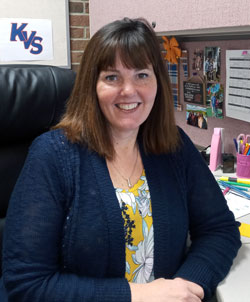Multiple districts — Headed into what is the third school year impacted by the global coronavirus pandemic, some area districts are making virtual learning options available to families who want their children to learn from home.
But while all districts offered some form of virtual learning last year, this year the offerings are more limited, where they exist at all.
Still, at least two districts have gone full speed in the other direction, making virtual a permanent option and opening attendance to students from other districts.
As of the first two days of school for districts Monday and Tuesday, Northview Public Schools had about 100 DK-12 students enrolled in the fully virtual option offered by the district, and recently has reopened DK-6 enrollment to allow more families.
‘This is a face-to-face business and virtual programs are not even a close second.’
— Kent City Superintendent Mike Weiler
Ryan Oshnock, Northview’s coordinator of student engagement and recovery, said that while in-person learning is always preferred, the district recognized that some students do better with or will have the need for virtual learning.
“We feel like this virtual model is going to be around for a while, so it would really be remiss if we didn’t try to offer that,” Oshnock said. “We can’t deny what’s happening in the world right now. There are going to be circumstances where students can’t attend in person.”
Kelloggsville Virtual School opened its virtual doors Aug. 23 to 91 students, including 86 from Kelloggsville — 32 elementary, 24 middle, and 29 high school — plus another five via a partnership with East Grand Rapids Public Schools. The elementary program is a hybrid model with some in-person learning, while the middle- and high-school program is fully virtual with the availability of in-person work.
“The pandemic showed us the possibilities for virtual education,” Director of Online Schools Beth Travis said in April, when plans were announced to make virtual learning permanent in the district. “It also showed us that virtual education wasn’t going away and could continue to be a good choice for families for multiple reasons beyond the pandemic. So we wanted to get started last fall already with our planning and get ahead of the game.”

‘We’ve Really Held Firm’
Kelloggsville also is partnering with Godfrey-Lee and East Grand Rapids on virtual education and in conversations with at least one other district. The program has two full-time elementary teachers, two full-time middle school teachers and four full-time high school teachers. KVS also shares with other district buildings four high-school elective teachers and a special education teacher.
“One appealing aspect is the option for students to attend some sessions in person,” said LeeAnn Stephan, EGR’s assistant superintendent of instruction. “The in-person option allows flexibility for both parents and students.”
Stephan added that it was clear in meetings with Kelloggsville that the district had researched and understood the changes in state rules and laws surrounding virtual learning, pupil accounting and instructional time.
“This year, Michigan public schools have limited flexibility with counting virtual learning as instructional time,” she said. “Due to these additional constraints, it was important to make sure that our K-6 program adhered to the new regulations. The Kelloggsville program is well organized, student focused, and they are always responsive to questions.”
Northview’s remote option, taught by district teachers, is for students who meet certain criteria such as being on track with course work and those who have already been successful in an online platform. Other requests are handled on a case-by-case basis, Oshnock said.
An agreement with Northview allows students in neighboring districts such as Forest Hills to be taught by Northview teachers when there is not an assigned teacher in the students’ home district.
Oshnock said the “overwhelming majority” of virtual students in Northview live in the district. Districts outside Northview will be invoiced for students who attend Northview’s virtual program.
‘We feel like this virtual model is going to be around for a while, so it would really be remiss if we didn’t try to offer that.’
— Ryan Oshnock, Northview Public Schools
He acknowledged that “it’s really hard once the school year begins to pivot (to virtual), because then you have staffing issues.”
“We’ve really held firm in offering this option,” he added. “Families feel good that we have it and our employees are proud of the work they have done.”
Deputy Superintendent Liz Cotter said the district has five teachers who are dedicated entirely to fully virtual DK-6 students, and several in grades 7-12 who are teaching both online and in-person students from classrooms. A portion of the district’s COVID relief funds were used to hire virtual teaching staff.

Some Districts Opting Out
Other districts cite a lack of interest among families and the benefits of in-person learning as reasons to not offer a virtual option — Caledonia, Cedar Springs and Kent City among them.
Caledonia Superintendent Dedrick Martin said they opened sign-ups for online learning a few months ago, but numbers were so low they decided not to offer it. He also explained their desire to move forward from “pandemic-style learning” and “refocus efforts (on) keeping students in classrooms, learning face to face.”
Kent City Superintendent Mike Weiler said he was unaware of any requests from families in his district. “Getting kids back into schools is a priority,” he said. “This is a face-to-face business and virtual programs are not even a close second.”
Weiler said that if school buildings were ordered to shut down again, his district would “revert to what we did” previously.
Students there and elsewhere, however, are not without options.
All districts must offer a minimum number of online courses. Effective in October, state law allows K-12 students to take up to two courses through Michigan Virtual at no cost, and more than two if a student meets certain requirements. Districts have discretion to deny students in grades K-5 from being enrolled in virtual learning if they have not previously done well.
High school students also have the option to take core classes through Michigan-based Link Learning.
Janice Holst and Phil de Haan contributed to this story
Offerings Elsewhere
Following is a sampling of what some other districts across Kent County are offering in the way of virtual learning:
Byron Center
Students in grades 7-12 can opt to enroll in online learning through Edgenuity.
Comstock Park
A virtual option is available for grades K-12. Enrollment is significantly lower than last year, Superintendent David Washburn said. Five percent of 6-12h-graders are attending virtually and fewer than 2 percent of the district’s K-5 students.
Forest Hills
Virtual offerings are so far limited to students who demonstrate a medical necessity. Pre-K-6 students will be placed with district teachers where possible, and students in grades 7-12 will attend via an agreement with Northview Public Schools. (See story for more information.)
Godfrey-Lee
Currently, online option requests are approved for documented medical reasons only.
Grand Rapids
GRPS offers a K-12 virtual school option limited to students or immediate household members who have a documented medical condition. Jonathan Harper, director of curriculum at GRPS, said the district currently has about 30 students enrolled in virtual learning, provided through Edgenuity with district teacher mentors. “Our intent is to have as many GRPS students attending school 100% in-person as possible,” Harper said.
Grandville
The district has one virtual classroom for each elementary grade, taught by Grandville teachers. An online, third-party option is available for those in grades 7-12.
Kentwood
There is a virtual option for elementary students who are at-risk medically or who have someone in their household who is. Sixth- through 12th-graders can opt for the Kentwood International Virtual Academy. As of last week, 20 elementary and 60 students in grades 6-12 were enrolled in learning virtually.
Lowell
Students can enter or leave LAS Academy at the beginning of each trimester. To start this year there were 27 students in grades 1-5 learning virtually, compared with more than 100 kindergartners through fifth-graders last fall; and 39 middle- and high-school students enrolled in the academy, compared with more than 200 last fall.
Rockford
Kelly Amshey, principal of Rockford Virtual School, said enrollment is down substantially since last year, though they do expect approximately 40 students in elementary grades and approximately 100 in grades 7-12.
Sparta
Superintendent Pete Bush said the district is working to accommodate a handful of K-5 students whose families have requested virtual learning.
Wyoming
No virtual option for students in grades K-6. The district currently has approximately 225 students learning virtually in grades 7-12 who were approved because they have demonstrated success with online learning.
Compiled by School News Network staff









